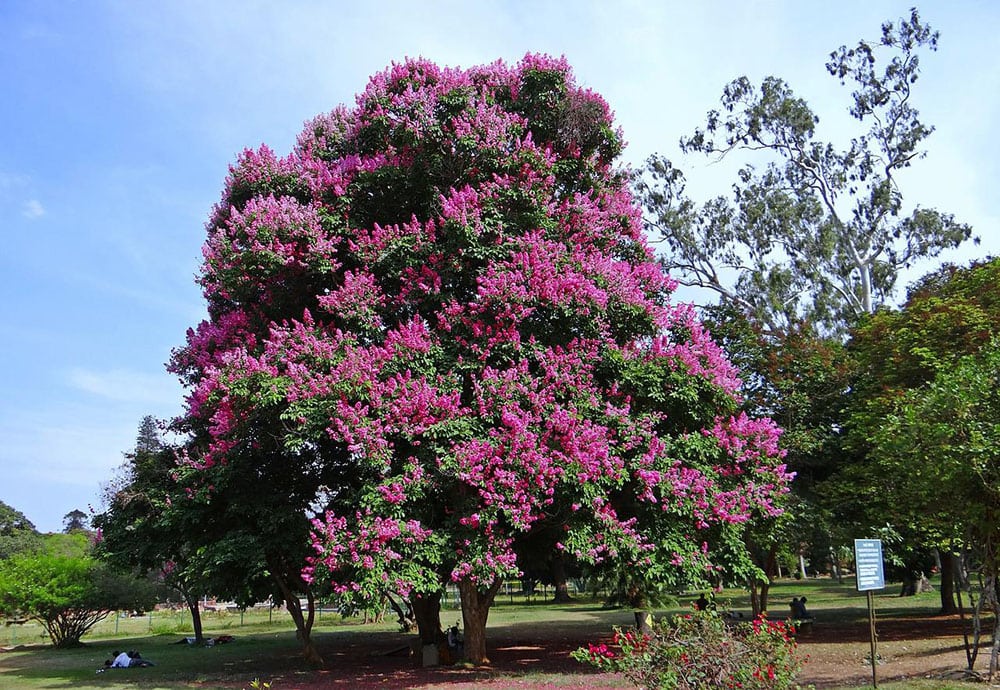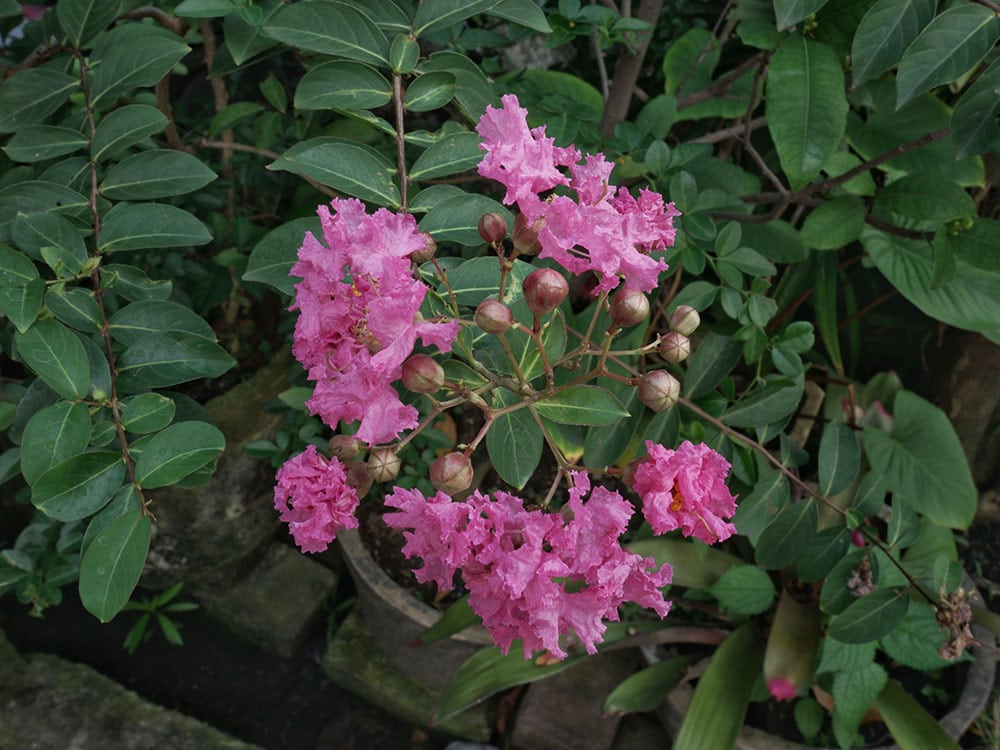How Fast Do Crape Myrtle Trees & Bushes Grow? Types & Care Tips
-

- Last updated:

Crape myrtles (Lagerstroemia spp) are popular ornamental trees or shrubs found in many yards and gardens. Their characteristic flowers make them a welcome addition to any landscape and a must-have for any garden owner. Plus, they’re also pretty low-maintenance, requiring only a little bit of water and some sunlight to grow and thrive.
If you recently planted your cape myrtles, you might be wondering how fast they grow and how tall they can get. Truth is, there is no simple answer as their growth rate differs. Keep reading to find out more.
Crape Myrtle: A Little Background
Crape myrtles are native to Asia and can be found in countries like India, China, Korea, and Japan. They were introduced to the United States in the early 1800s and have been a popular landscaping choice ever since.
Today, crape myrtles come in many different colors, shapes, and sizes. You can find them in colors like white, pink, red, and purple. They range in height from six feet to 30 feet tall. So, whether you’re looking for a small bush or a large tree, crape myrtles are always a great option.

How Fast Do Crape Myrtles Grow?
Crape myrtles are pretty fast-growing plants. In fact, they can grow up to three feet per year. But this all depends on the type of crape myrtle you have and the growing conditions. Let’s explore the different types of crape myrtle and their growth rates.
The Common Crape Myrtle
The common crape myrtle (Lagerstroemia Indica) is the most popular type of crape myrtle. It’s probably the one you’re thinking of when you think of crape myrtles. This shrub can grow up to three feet per year and can reach a height of 15 to 25 feet if you take good care of it.
The plant thrives best in full sun and well-drained soil. It is also pretty drought-tolerant, so you don’t have to water it very often. Just make sure you give it a good soaking every now and then to keep the roots healthy.
The Natchez Crape Myrtle
The Natchez crape myrtle (Lagerstroemia Natchitoches) is a hybrid crape myrtle that was created by crossing the common crape myrtle with the Muskogee crape myrtle. This crape is slower-growing than the common crape myrtle, only reaching heights of 15 to 20 feet.
The Natchez crape myrtle is also a bit more tolerant of cold weather and can even handle some frost. So, if you live in an area with cooler winters, this might be the crape myrtle for you.
The Muskogee Crape Myrtle
The Muskogee crape myrtle (Lagerstroemia Indica x Fauriei) is the largest crape myrtle, reaching heights of 25 to 30 feet if well taken care of. However, it’s also one of the slowest-growing crape myrtles, only reaching heights of two to three feet per year.
The Muskogee crape myrtle is a bit more tolerant of shade than the other crape myrtles, so it’s a good choice if you have a spot in your yard that doesn’t get a lot of sunlight. But you’ll need to give it a bit more water than the other crape myrtles, as it’s not as drought-tolerant.
Semi-Dwarf Crape Myrtle
The semi-dwarf crape myrtle (Lagerstroemia x ‘Natchez’) is a smaller crape myrtle variety, only reaching heights of six to 12 feet. This crape myrtle is great for small yards or gardens as it doesn’t take up a lot of space.
Despite its small size, the semi-dwarf crape myrtle is a pretty fast-growing plant and can reach heights of two to three feet per year. Its bright pink flowers and widespread popularity make it a great choice for many gardeners.
How to Take Good Care of Your Cape Myrtle for Faster Growth
Now that you know all about the different types of crape myrtles and their growth rates, let’s talk about how to take care of your crape myrtle to encourage faster growth. Here are some tips for taking care of your crape myrtle:

Give It Adequate Sunlight
Crape myrtles need six to eight hours of sunlight per day to thrive. If you live in an area with hot summers, you might even want to give your crape myrtle a little bit of afternoon shade to protect it from the harsh sun.
If you live in a region that receives minimal sunlight, plant your crape myrtle near a south-facing wall to reflect some of the heat and light back onto the plant. Alternatively, you can try artificial light sources like grow lights to give your plant the sunlight it needs.
Give It Just Enough Water
Crape myrtles are pretty drought-tolerant, so you don’t need to water them very often. However, they do need to be watered deeply and regularly during their first growing season to help them establish a strong root system.
Once your crape myrtle is established, you can back off on the watering. During the summer, you only need to water your crape myrtle once a week. If you live in an area with high rainfall, you might not need to water your crape myrtle at all.
Remember, underwatering or overwatering is incredibly detrimental to the plant.
Fertilize Your Cape Myrtle as Required
You’ll need to fertilize your crape myrtles at least two to three times per year for healthy growth. A slow-release fertilizer or a water-soluble fertilizer works best because it won’t burn the plant’s roots.
For water-soluble fertilizers, make sure you dilute them before applying them. If you’re not sure how much fertilizer to use, follow the manufacturer’s instructions. You can also have your soil tested by a local extension office to find out which nutrients it’s lacking and how much fertilizer you should use.
Prune on Time
Crape myrtles don’t necessarily need to be pruned, but many people choose to do so to shape the plant or encourage the growth of more flowers. If you do decide to prune your crape myrtle, make sure you do it in late winter or early spring before new growth begins.
When pruning, always use sharp, clean pruning shears to avoid transferring infections. And don’t be afraid to prune aggressively – crape myrtles are pretty tough plants and can handle being cut back quite a bit.
Conclusion
As you can see, crape myrtles come in a wide range of sizes and shapes. And while they all have different growth rates, they can all grow pretty quickly if you take good care of them and provide them with proper growth conditions. To encourage fast growth, make sure you give your plant adequate sunlight, water, and fertilizer. Also, don’t forget to prune it occasionally to encourage new growth.
Featured Image Credit: Bishnu Sarangi, Pixabay
Contents


